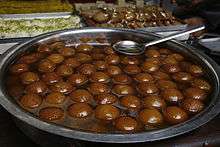Gulab jamun
|
Gulab jamun topped with almond slivers | |
| Alternative names | Gulab Jaman (Northern India/Pakistan), Lal Mohan (North India/Nepal), Gulabjam/Gulapjam (Eastern India/Bangladesh) |
|---|---|
| Course | Dessert |
| Place of origin | Indian subcontinent |
| Region or state | Indian subcontinent, Mauritius, Fiji, southern and eastern Africa, the Caribbean, the Malay Peninsula |
| Serving temperature | Hot, cold, or room temperature |
| Main ingredients | Khoa, saffron |
| Variations | Kala jamun also known as Kalajam |
|
| |
Gulab jamun (also spelled gulaab jamun) is a milk-solid-based South Asian sweet, particularly popular in the Indian subcontinent, notably India, Nepal (where it is known as lal mohan), Pakistan and Bangladesh, as well as Myanmar. It is also common in Mauritius Fiji, southern and eastern Africa, Malay Peninsula, and the Caribbean countries of Trinidad and Tobago, Guyana, Suriname and Jamaica. It is made mainly from milk solids, traditionally from freshly curdled milk. It is often garnished with dried nuts like almonds to enhance flavour.
Preparation
In India, milk solids are prepared by heating milk over a low flame for a long time until most of the water content has evaporated. These milk solids, known as khoya in India, Nepal, Bangladesh and Pakistan, are kneaded into a dough, sometimes with a pinch of flour, and then shaped into small balls and deep-fried at a low temperature of about 148 °C.[1] The balls are then soaked in a light sugary syrup flavored with green cardamom and rose water, kewra or saffron.[2] Gulab jamun is available commercially, at South Asian restaurants or pre-prepared either in tins or as kits to be prepared at home. It is not cheese.
Origins
Gulab jamun was first prepared in medieval India, derived from a fritter that Central Asian Turkic invaders brought to India.[3] One theory claims that it was accidentally prepared by the Mughal emperor Shah Jahan's personal chef.[4]
The word "gulab" is derived from the Persian words gol (flower) and āb (water), referring to the rose water-scented syrup. "Jamun" or "jaman" is the Hindi-Urdu word for Syzygium jambolanum, an Indian fruit with a similar size and shape. The Arab dessert luqmat al-qadi is similar to gulab jamun, although it uses a completely different batter. According to the culinary historian Michael Krondl, both luqmat al-qadi and gulab jamun may have derived from a Persian dish, with rose water syrup being a common connection between the two.[5]
Consumption customs
Gulab jamun is a dessert often eaten at festivals, birthdays or major celebrations such as marriages, the Muslim celebrations of Eid ul-Fitr and Eid al-Adha, and the Hindu festival of Diwali (the Indian festival of light). There are various types of gulab jamun and every variety has a distinct taste and appearance.
Variants
Gulab jamun gets its brownish red color because of the sugar content in the milk powder (khoya). In other types of gulab jamun, sugar is added in the batter, and after frying, the sugar caramelization gives it its dark, almost black color, which is then called kala jam or "black jam". The sugar syrup may be replaced with (slightly) diluted maple syrup for a gulab jamun with a Canadian flavor.
Homemade gulab jamun is usually made up of powdered milk, a pinch of all-purpose flour (optional), baking powder and clarified butter (ghee); kneaded to form a dough, moulded into balls, deep fried and dropped into simmering sugar syrup.
Pantua is similar to gulab jamun, and could be called a Bengali variant of that dish.[4] Ledikeni, a variation of Pantua, is another variant of gulab jamun.[6] It is said to have been invented by Bhim Chandra Nag on the occasion of the a visit by Lady Canning, the wife of Charles Canning, the Governor-General of India during 1856-62.
In central India, Gulab Jamun is termed Rasgulla. Katangi, a town near Jabalpur is famous for "Jhurre Ka Rasgulla", which has been made for the past 100 years.[7][8] It is several times in size of regular Gulabjamuns and is prepared in local desi ghee.[9]
In Rajasthan, instead of soaking gulab jamun balls in sugar syrup, they are cooked in gravy made from nuts and tomato to make popular Gulab Jamun ki Sabzi.
See also
References
- ↑ Marty Snortum, Lachu Moorjani (2005). Ajanta: regional feasts of India. Gibbs Smith. p. 17. ISBN 1-58685-777-0.
- ↑ shraddha.bht. "Gulab Jamoon". Konkani Recipes. Retrieved 25 May 2010.
- ↑ Michael Krondl (1 June 2014). The Donut: History, Recipes, and Lore from Boston to Berlin. Chicago Review Press. p. 7. ISBN 978-1-61374-673-8.
- 1 2 Charmaine O'Brien (2003). Flavours Of Delhi: A Food Lover's Guide. Penguin Books Limited. p. 145. ISBN 978-93-5118-237-5.
- ↑ Michael Krondl (2011). Sweet Invention: A History of Dessert. Chicago Review Press. p. 38. ISBN 978-1-55652-954-2.
- ↑ Richardson, Tim H. (2002). Sweets: A History of Candy. Bloomsbury USA. p. 334. ISBN 1-58234-229-6.
- ↑ http://www.patrika.com/news/jabalpur/testy-gulab-jamun-of-katangi-20157/ यहां के रसगुल्लों के लिए थम जाते हैं वाहनों के पहिए, Patrika, 1/10/2016
- ↑ उसमें प्राण जगाओ साथी- 3, मायाराम सुरजन, Deshbandhu, 2009-11-12, जबलपुर-दमोह के बीच कटंगी के रसगुल्ले, 1959
- ↑ Katangi ke Rasgulla. Akash Sahu, May 31, 2016
External links
| Wikimedia Commons has media related to Gulab jamun. |
_bright.jpg)






